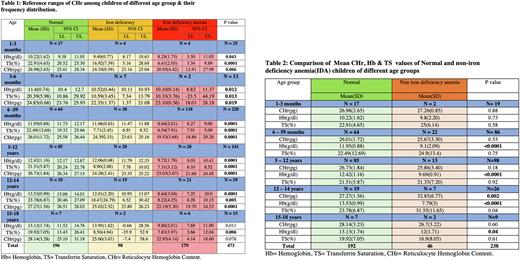Abstract
Iron Deficiency(ID) implies depletion of body iron stores which if not treated can progress to Iron Deficiency Anemia(IDA). Other than anemia, ID has been linked with poor cognitive development, behaviour problems, impairment of the immune system any many others. Reticulocyte Hemoglobin Content (CHr) a newer reticulocyte parameter available in CBC coulter counter is a promising parameter for picking up iron deficiency before it progresses to IDA. However its normal ranges in various age groups are not established. Early detection of ID in pediatric population will help us in prevention of its progression to IDA.
Objectives Estimate the burden of Iron deficiency and IDA in children visiting pediatric tertiary care hospital.
Determine the reference range of CHr in normal children & clinical utility of CHr as an alternative of iron studies for picking up iron deficiency.
Methods Prospective, Cross- section study, performed on Children between 1 month to 18 years of age, over 5 months period. All children undergoing a CBC test were included in the study after taking informed consent. Children who received blood transfusion in past 3 months, on hematinic therapy, an established hematological disorder, malignancy or Chronic liver and renal disorders were excluded. Reticulocyte parameters and iron studies were done for included children.
Based on CBC & iron profile patients were divided into 4 groups. 1) Normal- Normal Hemoglobin (Hb) and No Iron deficiency (ID). 2) Iron deficiency- Normal Hb with ID. 3) Iron deficiency Anemia- Low Hb with ID 4) Non-iron deficiency anemia- Low Hb and no ID. WHO definition was used to identify children with anemia. To identify iron deficiency Transferrin saturation(TS)% levels were used. (TS<12% for 6 months to 5 years, 14% for 5-10 years & <16% for >10 years). For Children < 6 months, age wise nomograms were used.
Results Of the 520 patients included in the study 37.6% (196) were Normal, 18.8% (98) had ID, 34.4% (179) had IDA and 9.2% (47) had non-IDA.
Prevalence of anemia in our study population was 43.46% (226/520) with maximum prevalence of IDA i.e 79.2% (179/226) amongst all anemic children.
Burden of ID was 34.4% in our population. Maximum burden of ID and IDA was in the age group of 6 month - 59 months i.e 38.8% and 65.9% respectively.
Mean (SD) values of CHr in normal children of different age groups were: 1to 3 months 26.98(2.65), 3 to 6 months 24.85(0.68), 6 months to 59 months 26.01(1.72), 5 to12 years 26.73(1.84), 12 -14 years 27.27(1.56) and 15 to 18 years 28.14(3.28) (Table 1).
We noted that mean values of CHr were significantly higher in normal children when compared with children having ID and IDA (Table 1).
However, in the children of 15-18 years age group statistical significance was not reached as the number of children in this age group were less.
Comparison of mean CHr values of normal children with non-IDA children did not show any difference (Table 2) and in children between 12-14 years it was significantly higher in non-IDA 32.85 vs 27.27 in normal children (p value-0.002). We also noted a significantly higher TS% in non-IDA children of this age group, which signifies a good correlation of CHr with TS%.
There was only one child of non-IDA with CHr of 22.4 vs 7 normal children with mean CHr of 24.85 in age group of 3-6 months.
Normal range of CHr for children between 6 months to 59 months was 25.58 to 26.44 and 5 to 12 years was 26.63 to 27.13 (Table 1). Data in other age group was in similar range, but is not conclusive due to lesser number of patients.
Area under the curve (AUC) of CHr for normal children between 6-59 months was 0.89 with 95% CI of 0.85 to 0.93 and for children between 5-12 years was 0.80 with 95% CI of 0.72 to 0.88. Correlation(spearmen) between TS% & CHr among children of 6-59 months and 5-12 years was, 0.70 (p value - 0.0001) and 0.48 (p value- 0.0001) respectively.
Iron studies cost 2 times more than the cost of getting CBC and CHr test. As CHr is done in the same CBC machine there is no need of an extra sample/prick as required for iron studies.
Conclusion Prevalence of ID and IDA is high in our cohort. In our study we established that CHr in normal and non-IDA conditions is higher than in ID and IDA. Our study concludes good correlation of CHr with TS% and therefore we suggest it to be a cost-effective alternative of iron studies. With the help of Normal ranges of CHr established in this study we will be able to identify ID and intervene early hence reduce associated morbidities in our population.
Disclosures
No relevant conflicts of interest to declare.
Author notes
Asterisk with author names denotes non-ASH members.


This feature is available to Subscribers Only
Sign In or Create an Account Close Modal